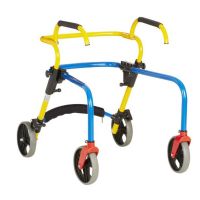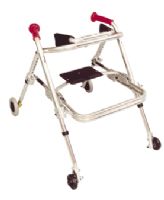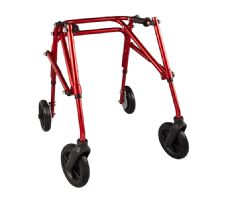 Written by Hulet Smith, OT
Written by Hulet Smith, OT
Your child’s first steps are important. However, due to mobility challenges, some children will need assistance to walk safely and independently. Our buying guide provides everything you need to know about pediatric walkers, how to choose the best for your child’s unique requirements, and recommends the best products along the way.
A pediatric walker is a mobility aid that provides balance and stability when walking. They are used by children who can bear some weight through their legs and take steps but still require assistance. Pediatric walkers are not the same as baby walkers.
No, but they are very similar! The biggest difference between a walker and a gait trainer is the level of support offered. Gait trainers typically offer much more support than walkers and are used with children who cannot bear their weight through their legs, helping kids to learn or relearn how to walk. Technically, you can convert a walker into a gait trainer if you were to add many support-type accessories, such as a trunk or pelvic harness.
Any child who can mostly or fully bear their weight and take a few steps, but still needs some support for balance and stability while walking could use a pediatric walker. Some walkers can be converted into gait trainers for children who are not able to bear as much weight and require more support while walking. Pediatric walkers are available in a wide range of styles to suit both short-term and long-term walking support needs. They’re frequently utilized following an injury or surgery, during physical therapy, and for long-term disabilities.
The Nimbo Walker is a brand-name product made by Inspired by Drive. The Klip, by comparison, is an almost identical product made by Circle Specialty. These are four-wheel, anterior-design gait trainers and are favored by therapists, parents, and the young users themselves. The Klip and the Nimbo both deliver exceptional functionality at an affordable cost. Encouraging upright posture while they enhance stride length and velocity, these devices offer a wide selection of optional upgrades to customize their performance to every user’s unique needs. Available in multiple sizes to fit very small children to adults, the Klip and the Nimbo feature height-adjustable handles and lightweight, foldable frames for easy transport and storage. For a more in-depth guide, check out our comprehensive article on the differences, pros, and cons between the Klip and the Nimbo.
To choose a pediatric walker for your child, the best first step is to talk to your child’s doctor and/or therapist team. To narrow your choices, some of the most important points to consider include:
A pediatric walker is used by standing behind the walker frame if it’s an anterior design, or standing in front of the walker frame if it’s a posterior design. The child places their hands on the handle grips and steps forward using the walker frame for support and balance. Standard, non-wheeled walkers need to be lifted with each step, while fully wheeled walkers simply require pushing, similar to pushing a grocery cart. Forearm platforms can replace handle grips for kids with hand/wrist weakness or impairment.
Selecting the right height walker for your child makes all the difference in achieving safe, balanced, and posture-correct walking support. If the handle height is too high, it can cause bad postural habits. If the handle height is too low, it can cause forward slouching. Both situations can result in discomfort and pain for children. Most good manufacturers will have sizing guidelines and charts so parents can choose the perfect fit for each child. The easiest way to measure your child to determine the best handle height, or handle height range, is to have them keep their shoes on and stand up as straight as possible. Measure the crease of the wrist to the floor to choose the correct handle height for your child.
Some pediatric walkers appear backward because they are designed as posterior walkers. Also known as reverse walkers, posterior walkers are placed behind the child, providing support from the back. The child places their hands on the sides of the frame, pushing their weight down through their arms as they propel themselves forward, using the walker behind them for support and balance as they walk.
Deciding whether your child needs a pediatric walker or an adult walker is determined by size. If your child is especially large or tall, or if they’re a teenager, they may be better served by an adult walker. If your child is younger than 12 or is especially small, then a pediatric walker would be the better choice. If your child has a higher level of physical involvement, a pediatric walker with added support will generally be a better choice than an adult walker. Walkers designed for special needs children are specifically engineered to serve the needs of the developing child and usually come with more support options.
The weight capacity of a pediatric walker can vary greatly, depending on the model chosen. While most models can safely accommodate up to 175 pounds, there are several that can hold up to 350 pounds. Be sure to check the weight capacity before you purchase, adding 15-20 pounds to your child’s current weight to ensure that the walker you select can accommodate their weight safely as they grow. If your child’s weight falls at the upper end of the weight range, it’s a good idea to choose the next larger size.
There are other important design features to consider when you’re choosing the best pediatric walker for your child. Determining your child’s special needs will help you select a walker that meets those requirements with a variety of beneficial features.
The handle grips a walker comes with are made with many different types of materials including plastic and foam in softer or harder formats. Choosing the type of handgrip that corresponds with your child’s particular needs will help alleviate stress on their hand and wrist joints by enabling ergonomic positioning. Choose a larger grip for children who experience challenges grasping with their fingers, or forearm support for youngsters with hand and wrist impairments. Sweaty hands will require some kind of cover on the handle that is absorbent or tactile for a firm, non-slip grip.
Many walkers offer height adjustability or a “grow-with-your-child” design format, enabling longer-term use without the need to buy a new walker every year. Ideal for children with permanent or long-term disabilities, adjustable walker frames allow for constant alterations as your child grows larger, providing a cost-effective solution for support that lasts through the years.
If your family travels frequently or you need a more portable design for excursions by car, bus, plane, or boat, it’s best to choose a lightweight, foldable walker that collapses easily and is light enough to place in a trunk or under a seat. Foldable walkers are also preferable for compact storage, enabling you to place the walker in a closet or under the bed when it’s not needed.
Because they need to be light enough for small children to utilize, most pediatric walkers are constructed with lightweight aluminum or PVC that’s also corrosion-resistant and highly durable to ensure safe, long-lasting support. The walker’s other components, such as handle grips or seats, are usually made from foam or lightweight plastics so they don’t add too much weight.
Some pediatric walkers are colorfully designed to be more engaging for children. Bright, happy colors make the walker more appealing and fun, eliminating any kind of institutional or medical aesthetic. However, the color should not be an overly crucial deciding factor, as choosing a walker that’s medically suitable for your child’s needs is much more important.
For children who require additional mobility support, such as a trunk or a pelvic positioner, many walkers offer multiple add-on options to convert the walker into a gait trainer. Considering your child’s support needs can help you determine the specific options you’ll want to add. For children with increased adductor tone or those who tend to scissors while walking, ankle prompts or straps are helpful. Forearm platforms and trunk harnesses can help optimize control for head lifting, while head supports can be used for children unable to hold their heads up.
There are multiple accessories available for pediatric walkers, including replacement wheels, seats, harnesses/supports, and handle grips. Another popular pediatric walker accessory is a basket or bag that attaches to the walker for convenient portable storage.
Because they’re used by such a diverse community of children with differing needs, pediatric walkers are available in several different design types, including standard, two-wheel, four-wheel/rollator, forearm, and reverse/posterior.
 | Guardian Pediatric Folding Walker by Medline View Product |
A standard walker does not have any wheels. It features rubber tips on the bottom of each of its four legs to optimize traction. Standard walkers are great for children who have enough arm strength to raise the walker up with each step and move it forward. They’re also perfect for youngsters who require front-leaning support as they walk, optimizing balance for standing and walking with their anterior (in front of the child) format. Frequently used for short-term disability and recovery, this anterior style also facilitates easier transfers to and from a wheelchair.
 | Walk-On Pediatric Walker with Wheels - 24 in to 28 in Adjustable Height by Rebotec View Product |
Easier to propel than non-wheeled standard walkers, two-wheel walkers highlight two wheels on the front legs to enhance mobility and two rubber-tipped back legs to increase stability. Often used for both short and long-term disabilities, two-wheel walkers are a great choice for children who need a bit more assistance with posture control and correct positioning while walking. This pediatric walker with wheels facilitates balance support in an anterior format, with the walker placed in front of the child for forward-leaning mobility.
 | Pediatric Walker with Wheels - Fixi and Fox by Rebotec View Product |
Four-wheel walkers include a wheel on each of the four legs and are similar to pushing a grocery cart. Also known as rollators or rolling walkers, four-wheel walkers may include hand brakes for a secure stoppage and stationary standing, along with fold-down seats for resting when the child gets tired of walking. Generally much easier to maneuver for both indoor/outdoor use on all terrains, four-wheel walkers don’t need to be lifted between each step, making them a good choice for children who do not have adequate upper body or arm strength.
 | Fixi Yano Upright Pediatric Walker - Adjustable 35 in - 39 in by Rebotec View Product |
Useful for any child who is unable to grip a walker properly, forearm walkers enable youngsters with limited arm, wrist, and/or hand strength to utilize a walker for walking support. Also known as a platform walker or a forearm platform walker, this kind of pediatric rolling walker has forearm supports built-in or as an add-on option that can be applied and removed as needed. It eliminates the need for gripping, allowing users to rest their hands within the platform, and place their weight on their forearms to propel and steer the walker. Forearm walkers are the perfect mobility aid for kids challenged by balance, neurological, or mobility issues, along with those with weakened or injured hands, wrists, and arms.
 | Pluto Posterior Walker for Children by Rebotec View Product |
Offering improved posture alignment over anterior walkers, reverse/posterior walkers are placed behind the child as they walk. Although they may take a bit of a learning curve to master, most kids who use them often talk about how much more they love this design over their old anterior walker. Because there are no barriers in front of the child, this can help to encourage eye-to-eye interaction with their peers, fostering better social skills that make the child want to engage more with the world. Posterior walkers require less exertion and decrease double stance time while increasing walking velocity and promoting healthy, upright posture. Although they may be a little more challenging to transfer to and from a wheelchair, they provide more open access for the child to approach the environment in front of them, such as getting into a vehicle. Reverse walkers also usually have a fold-down seat for resting when the child tires.
In addition to the different walker styles, several specialty pediatric walkers offer a variety of different design benefits. These include walkers with seats, walkers for outdoor use, junior-sized and infant-sized walkers, and playtime walkers.
 | Kaye PostureRest Posterior Walkers with Seats View Product |
A pediatric walker with a seat will provide a resting place for your child to sit down when they are tired of walking. Many different types of walkers include a seat that conveniently folds up or flips out of the way when it’s not needed, especially four-wheeled walkers and posterior walkers.
 | Klip Gait Trainer Outdoor Walker w/ Big Wheels View Product |
Even if you already have a walker for indoor use, it’s always a good idea to have a walker specifically intended for safe outdoor use, especially for children. Outdoor walkers will have bigger tires that give them the capability to roll smoothly over any uneven or rough terrain, such as cobblestones, grass, sand, and even snow and ice. Rubber tires or flat-free tires are often utilized, as well as deeper treads to better grip the walking surface and swiveling capability for 360-degree maneuverability. Outdoor walkers also frequently include hand brakes to optimize control, allowing better control on hills and inclines. Fold-away seats are also typically included, providing a resting area for longer outdoor excursions.
 | Junior Height-Adjustable Folding Walker by McKesson View Product |
A junior-sized walker is generally intended for children between 4 feet to 5 feet two inches in height, with some models accommodating up to 350 pounds in weight. The age range for this size can vary, but it tends to be a good size for adolescents and/or taller or heavier children.
 | Marcy Rollator - Telescoping Rollator for Kids by Clarke Healthcare View Product |
Baby walkers are usually used by infants between 4 to 16 months of age, while pediatric walker designs that come in multiple size options often offer a smaller size that accommodates infants and small toddlers as well.
 | Kaye Wheeled Walker Wagons View Product |
Encouraging young children to walk with bright colors and fun designs, some walkers for children are “disguised” as toys to attract youngsters struggling with mobility to want to use them. Kids have no idea that they’re getting great walking training as they mobilize around the world with these playtime walkers!
Children living with temporary or permanent disabilities, especially those with severe motor impairments, tend to be less active than their able-bodied counterparts, exhibiting more sedentary behavior and less motor skill development. They may also withdraw socially, especially in inaccessible environments they can’t mobilize safely within.
However, assistive devices like pediatric walkers or pediatric wheeled walkers can give kids the access they need and deserve, helping them to stay active and get the exercise and movement they require to stay healthy. Available in a wide range of styles and sizes, pediatric walkers give children and teens freedom and independence to move about their world with safety and ease.
If you’re looking for more ways to make informed purchasing decisions, learn more caregiving and special needs parenting tips, or find medical product reviews and comparisons like this one, we invite you to read more on our blog, Caregiver University!

Co-founder/CEO of Rehabmart, Pediatric Occupational Therapist, husband, and father. Passionate about connecting special needs kids with superb nutrition, sensory integration, and complementary health strategies. Excited about Rehabmart's mission to become the premier online educational platform which empowers caregivers by spotlighting innovative devices and interventions to achieve optimal patient response and recovery.